Individual Report: Business Organisation Analysis of Sainsbury's
VerifiedAdded on 2023/01/06
|11
|2905
|90
Report
AI Summary
This individual report provides a comprehensive analysis of business organizations, using Sainsbury's as a case study. The report begins with an introduction to business organizations and their significance in the economy. It then classifies different types of business organizations based on size (micro, small, medium, and large) and form (sole proprietorship, partnership, LLP, company, and cooperatives). The report further explores various organizational structures, with a focus on the functional structure adopted by Sainsbury's and how it affects business operations. A PESTLE analysis is conducted to evaluate the external factors impacting Sainsbury's performance, including political, economic, social, technological, and legal factors. The report concludes with a summary of findings and references used throughout the analysis. This analysis is valuable for understanding the complexities of business operations and the impact of external factors on business performance.
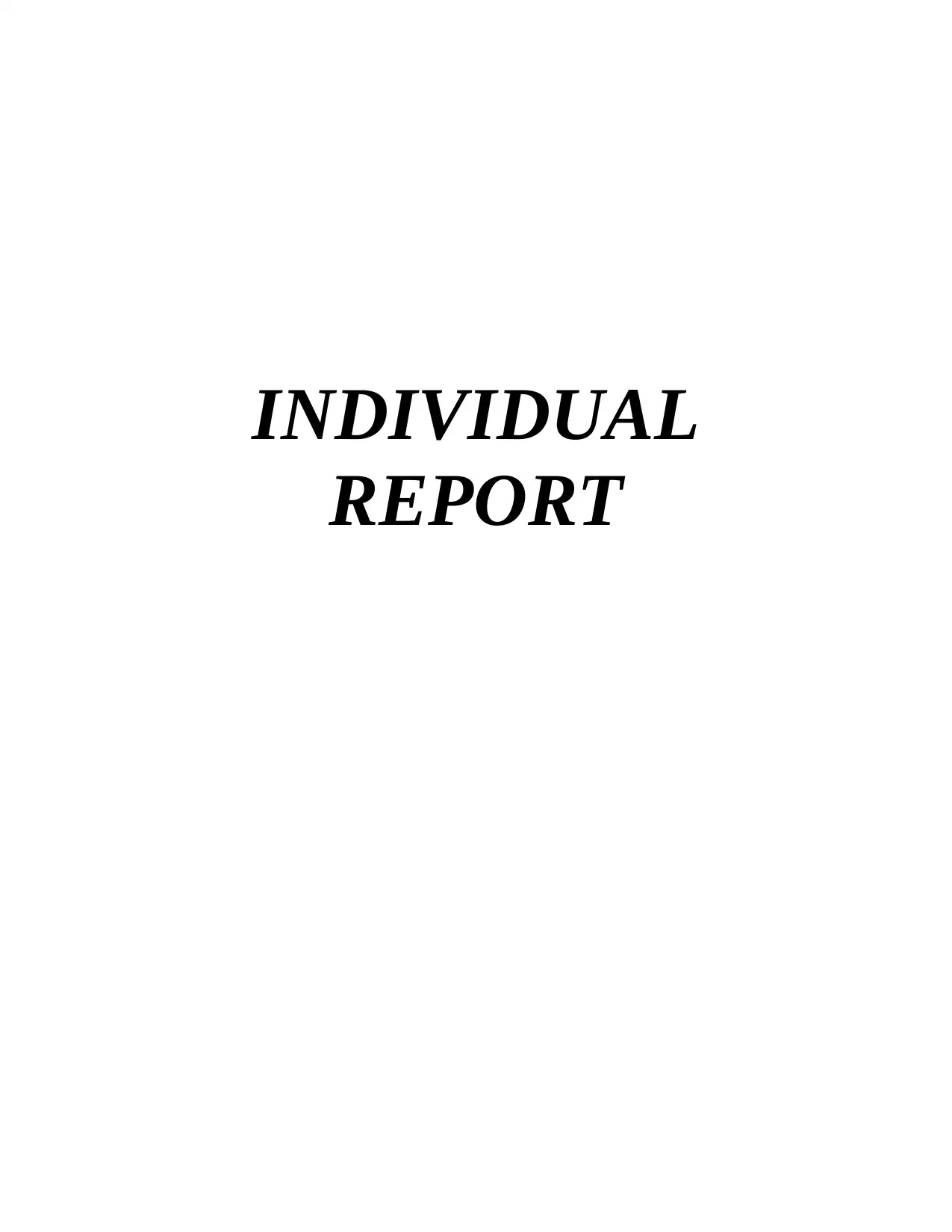
INDIVIDUAL
REPORT
REPORT
Paraphrase This Document
Need a fresh take? Get an instant paraphrase of this document with our AI Paraphraser
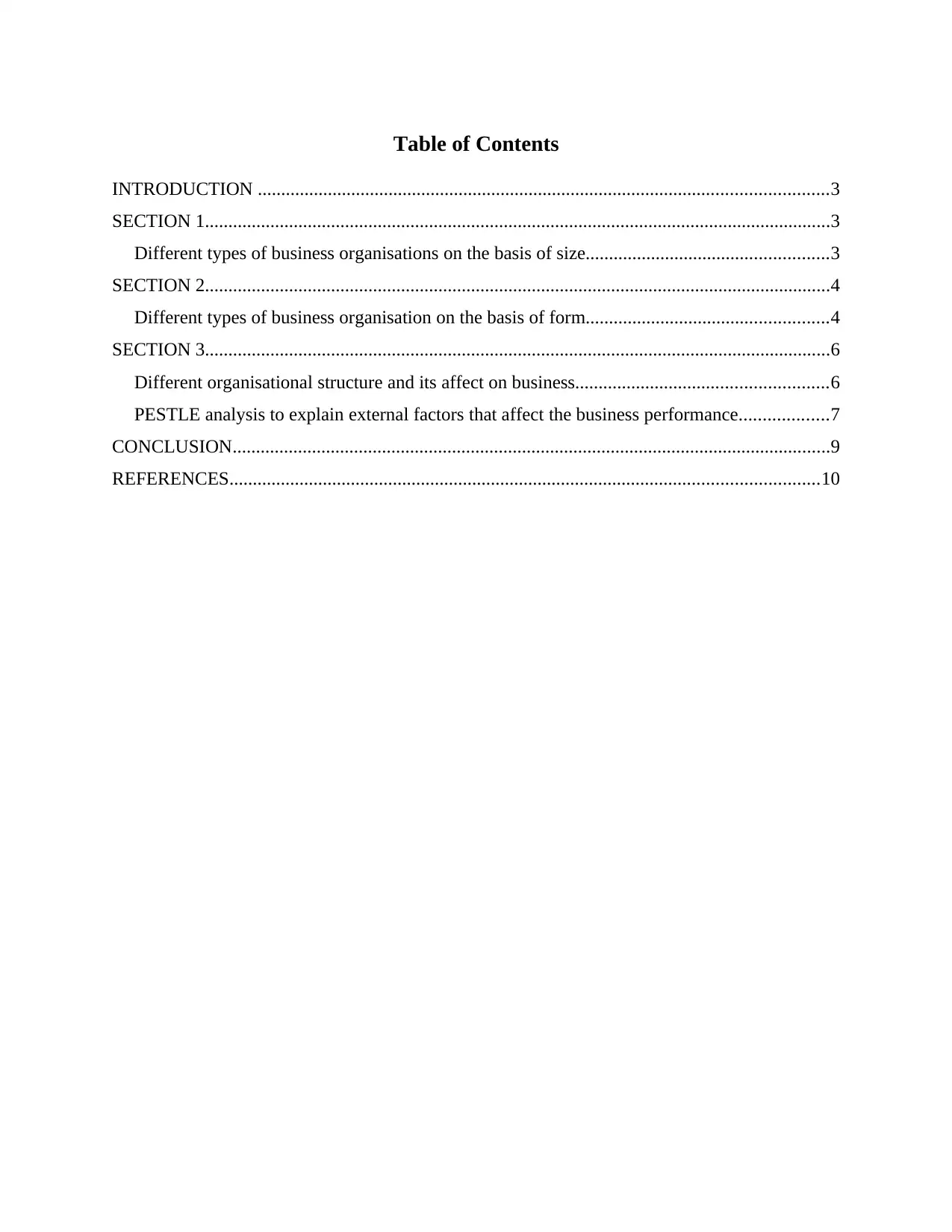
Table of Contents
INTRODUCTION ..........................................................................................................................3
SECTION 1......................................................................................................................................3
Different types of business organisations on the basis of size....................................................3
SECTION 2......................................................................................................................................4
Different types of business organisation on the basis of form....................................................4
SECTION 3......................................................................................................................................6
Different organisational structure and its affect on business......................................................6
PESTLE analysis to explain external factors that affect the business performance...................7
CONCLUSION................................................................................................................................9
REFERENCES..............................................................................................................................10
INTRODUCTION ..........................................................................................................................3
SECTION 1......................................................................................................................................3
Different types of business organisations on the basis of size....................................................3
SECTION 2......................................................................................................................................4
Different types of business organisation on the basis of form....................................................4
SECTION 3......................................................................................................................................6
Different organisational structure and its affect on business......................................................6
PESTLE analysis to explain external factors that affect the business performance...................7
CONCLUSION................................................................................................................................9
REFERENCES..............................................................................................................................10
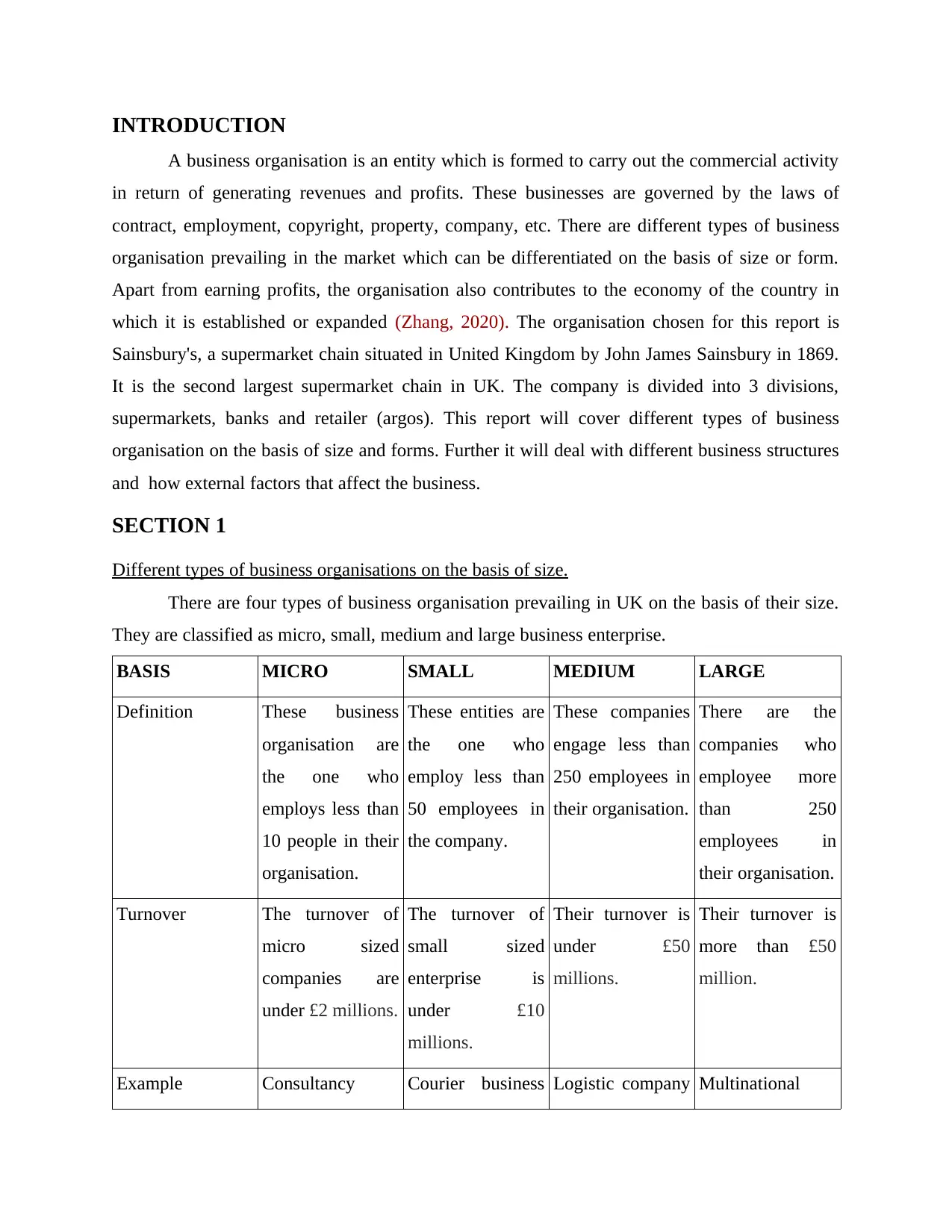
INTRODUCTION
A business organisation is an entity which is formed to carry out the commercial activity
in return of generating revenues and profits. These businesses are governed by the laws of
contract, employment, copyright, property, company, etc. There are different types of business
organisation prevailing in the market which can be differentiated on the basis of size or form.
Apart from earning profits, the organisation also contributes to the economy of the country in
which it is established or expanded (Zhang, 2020). The organisation chosen for this report is
Sainsbury's, a supermarket chain situated in United Kingdom by John James Sainsbury in 1869.
It is the second largest supermarket chain in UK. The company is divided into 3 divisions,
supermarkets, banks and retailer (argos). This report will cover different types of business
organisation on the basis of size and forms. Further it will deal with different business structures
and how external factors that affect the business.
SECTION 1
Different types of business organisations on the basis of size.
There are four types of business organisation prevailing in UK on the basis of their size.
They are classified as micro, small, medium and large business enterprise.
BASIS MICRO SMALL MEDIUM LARGE
Definition These business
organisation are
the one who
employs less than
10 people in their
organisation.
These entities are
the one who
employ less than
50 employees in
the company.
These companies
engage less than
250 employees in
their organisation.
There are the
companies who
employee more
than 250
employees in
their organisation.
Turnover The turnover of
micro sized
companies are
under £2 millions.
The turnover of
small sized
enterprise is
under £10
millions.
Their turnover is
under £50
millions.
Their turnover is
more than £50
million.
Example Consultancy Courier business Logistic company Multinational
A business organisation is an entity which is formed to carry out the commercial activity
in return of generating revenues and profits. These businesses are governed by the laws of
contract, employment, copyright, property, company, etc. There are different types of business
organisation prevailing in the market which can be differentiated on the basis of size or form.
Apart from earning profits, the organisation also contributes to the economy of the country in
which it is established or expanded (Zhang, 2020). The organisation chosen for this report is
Sainsbury's, a supermarket chain situated in United Kingdom by John James Sainsbury in 1869.
It is the second largest supermarket chain in UK. The company is divided into 3 divisions,
supermarkets, banks and retailer (argos). This report will cover different types of business
organisation on the basis of size and forms. Further it will deal with different business structures
and how external factors that affect the business.
SECTION 1
Different types of business organisations on the basis of size.
There are four types of business organisation prevailing in UK on the basis of their size.
They are classified as micro, small, medium and large business enterprise.
BASIS MICRO SMALL MEDIUM LARGE
Definition These business
organisation are
the one who
employs less than
10 people in their
organisation.
These entities are
the one who
employ less than
50 employees in
the company.
These companies
engage less than
250 employees in
their organisation.
There are the
companies who
employee more
than 250
employees in
their organisation.
Turnover The turnover of
micro sized
companies are
under £2 millions.
The turnover of
small sized
enterprise is
under £10
millions.
Their turnover is
under £50
millions.
Their turnover is
more than £50
million.
Example Consultancy Courier business Logistic company Multinational
⊘ This is a preview!⊘
Do you want full access?
Subscribe today to unlock all pages.

Trusted by 1+ million students worldwide
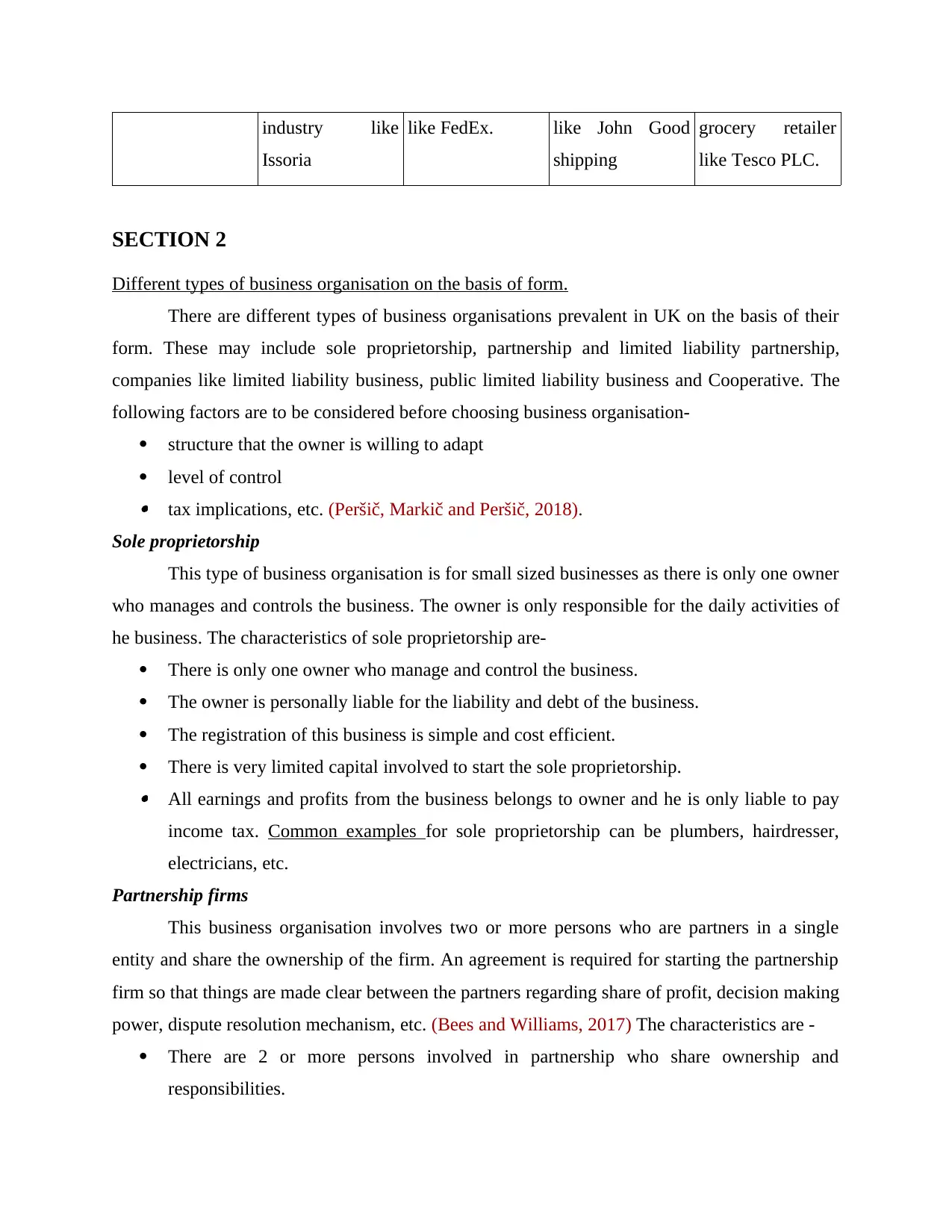
industry like
Issoria
like FedEx. like John Good
shipping
grocery retailer
like Tesco PLC.
SECTION 2
Different types of business organisation on the basis of form.
There are different types of business organisations prevalent in UK on the basis of their
form. These may include sole proprietorship, partnership and limited liability partnership,
companies like limited liability business, public limited liability business and Cooperative. The
following factors are to be considered before choosing business organisation-
structure that the owner is willing to adapt
level of control tax implications, etc. (Peršič, Markič and Peršič, 2018).
Sole proprietorship
This type of business organisation is for small sized businesses as there is only one owner
who manages and controls the business. The owner is only responsible for the daily activities of
he business. The characteristics of sole proprietorship are-
There is only one owner who manage and control the business.
The owner is personally liable for the liability and debt of the business.
The registration of this business is simple and cost efficient.
There is very limited capital involved to start the sole proprietorship. All earnings and profits from the business belongs to owner and he is only liable to pay
income tax. Common examples for sole proprietorship can be plumbers, hairdresser,
electricians, etc.
Partnership firms
This business organisation involves two or more persons who are partners in a single
entity and share the ownership of the firm. An agreement is required for starting the partnership
firm so that things are made clear between the partners regarding share of profit, decision making
power, dispute resolution mechanism, etc. (Bees and Williams, 2017) The characteristics are -
There are 2 or more persons involved in partnership who share ownership and
responsibilities.
Issoria
like FedEx. like John Good
shipping
grocery retailer
like Tesco PLC.
SECTION 2
Different types of business organisation on the basis of form.
There are different types of business organisations prevalent in UK on the basis of their
form. These may include sole proprietorship, partnership and limited liability partnership,
companies like limited liability business, public limited liability business and Cooperative. The
following factors are to be considered before choosing business organisation-
structure that the owner is willing to adapt
level of control tax implications, etc. (Peršič, Markič and Peršič, 2018).
Sole proprietorship
This type of business organisation is for small sized businesses as there is only one owner
who manages and controls the business. The owner is only responsible for the daily activities of
he business. The characteristics of sole proprietorship are-
There is only one owner who manage and control the business.
The owner is personally liable for the liability and debt of the business.
The registration of this business is simple and cost efficient.
There is very limited capital involved to start the sole proprietorship. All earnings and profits from the business belongs to owner and he is only liable to pay
income tax. Common examples for sole proprietorship can be plumbers, hairdresser,
electricians, etc.
Partnership firms
This business organisation involves two or more persons who are partners in a single
entity and share the ownership of the firm. An agreement is required for starting the partnership
firm so that things are made clear between the partners regarding share of profit, decision making
power, dispute resolution mechanism, etc. (Bees and Williams, 2017) The characteristics are -
There are 2 or more persons involved in partnership who share ownership and
responsibilities.
Paraphrase This Document
Need a fresh take? Get an instant paraphrase of this document with our AI Paraphraser
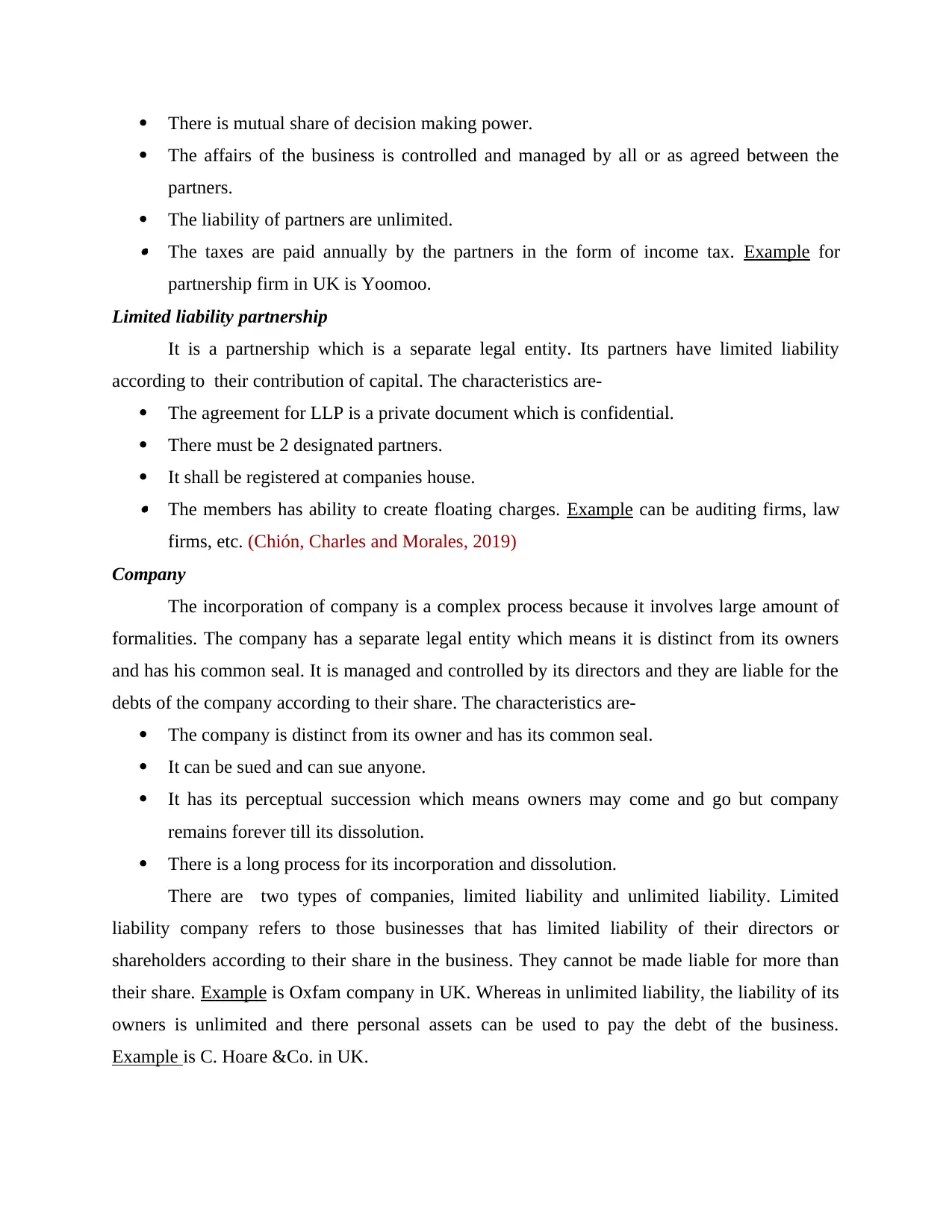
There is mutual share of decision making power.
The affairs of the business is controlled and managed by all or as agreed between the
partners.
The liability of partners are unlimited. The taxes are paid annually by the partners in the form of income tax. Example for
partnership firm in UK is Yoomoo.
Limited liability partnership
It is a partnership which is a separate legal entity. Its partners have limited liability
according to their contribution of capital. The characteristics are-
The agreement for LLP is a private document which is confidential.
There must be 2 designated partners.
It shall be registered at companies house. The members has ability to create floating charges. Example can be auditing firms, law
firms, etc. (Chión, Charles and Morales, 2019)
Company
The incorporation of company is a complex process because it involves large amount of
formalities. The company has a separate legal entity which means it is distinct from its owners
and has his common seal. It is managed and controlled by its directors and they are liable for the
debts of the company according to their share. The characteristics are-
The company is distinct from its owner and has its common seal.
It can be sued and can sue anyone.
It has its perceptual succession which means owners may come and go but company
remains forever till its dissolution.
There is a long process for its incorporation and dissolution.
There are two types of companies, limited liability and unlimited liability. Limited
liability company refers to those businesses that has limited liability of their directors or
shareholders according to their share in the business. They cannot be made liable for more than
their share. Example is Oxfam company in UK. Whereas in unlimited liability, the liability of its
owners is unlimited and there personal assets can be used to pay the debt of the business.
Example is C. Hoare &Co. in UK.
The affairs of the business is controlled and managed by all or as agreed between the
partners.
The liability of partners are unlimited. The taxes are paid annually by the partners in the form of income tax. Example for
partnership firm in UK is Yoomoo.
Limited liability partnership
It is a partnership which is a separate legal entity. Its partners have limited liability
according to their contribution of capital. The characteristics are-
The agreement for LLP is a private document which is confidential.
There must be 2 designated partners.
It shall be registered at companies house. The members has ability to create floating charges. Example can be auditing firms, law
firms, etc. (Chión, Charles and Morales, 2019)
Company
The incorporation of company is a complex process because it involves large amount of
formalities. The company has a separate legal entity which means it is distinct from its owners
and has his common seal. It is managed and controlled by its directors and they are liable for the
debts of the company according to their share. The characteristics are-
The company is distinct from its owner and has its common seal.
It can be sued and can sue anyone.
It has its perceptual succession which means owners may come and go but company
remains forever till its dissolution.
There is a long process for its incorporation and dissolution.
There are two types of companies, limited liability and unlimited liability. Limited
liability company refers to those businesses that has limited liability of their directors or
shareholders according to their share in the business. They cannot be made liable for more than
their share. Example is Oxfam company in UK. Whereas in unlimited liability, the liability of its
owners is unlimited and there personal assets can be used to pay the debt of the business.
Example is C. Hoare &Co. in UK.
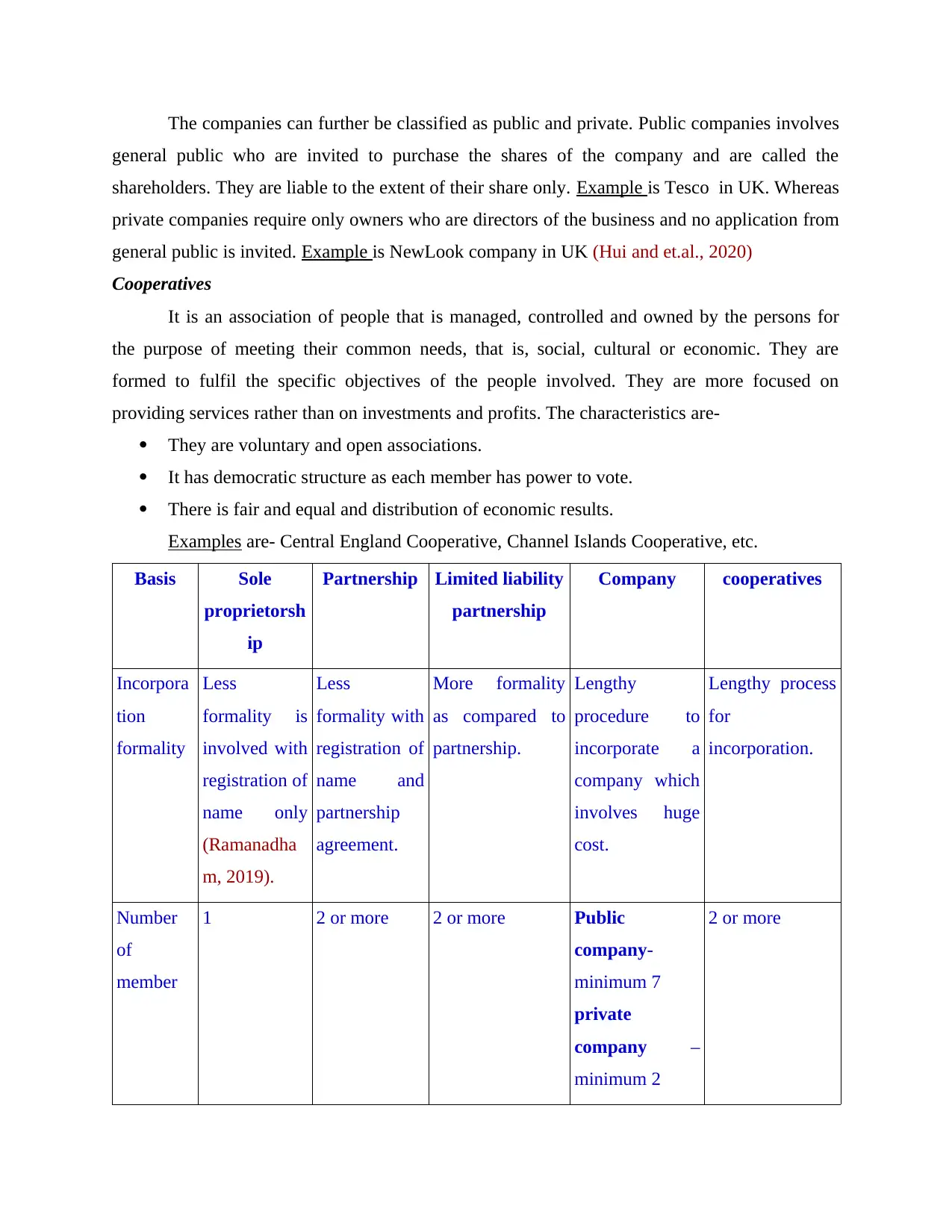
The companies can further be classified as public and private. Public companies involves
general public who are invited to purchase the shares of the company and are called the
shareholders. They are liable to the extent of their share only. Example is Tesco in UK. Whereas
private companies require only owners who are directors of the business and no application from
general public is invited. Example is NewLook company in UK (Hui and et.al., 2020)
Cooperatives
It is an association of people that is managed, controlled and owned by the persons for
the purpose of meeting their common needs, that is, social, cultural or economic. They are
formed to fulfil the specific objectives of the people involved. They are more focused on
providing services rather than on investments and profits. The characteristics are-
They are voluntary and open associations.
It has democratic structure as each member has power to vote.
There is fair and equal and distribution of economic results.
Examples are- Central England Cooperative, Channel Islands Cooperative, etc.
Basis Sole
proprietorsh
ip
Partnership Limited liability
partnership
Company cooperatives
Incorpora
tion
formality
Less
formality is
involved with
registration of
name only
(Ramanadha
m, 2019).
Less
formality with
registration of
name and
partnership
agreement.
More formality
as compared to
partnership.
Lengthy
procedure to
incorporate a
company which
involves huge
cost.
Lengthy process
for
incorporation.
Number
of
member
1 2 or more 2 or more Public
company-
minimum 7
private
company –
minimum 2
2 or more
general public who are invited to purchase the shares of the company and are called the
shareholders. They are liable to the extent of their share only. Example is Tesco in UK. Whereas
private companies require only owners who are directors of the business and no application from
general public is invited. Example is NewLook company in UK (Hui and et.al., 2020)
Cooperatives
It is an association of people that is managed, controlled and owned by the persons for
the purpose of meeting their common needs, that is, social, cultural or economic. They are
formed to fulfil the specific objectives of the people involved. They are more focused on
providing services rather than on investments and profits. The characteristics are-
They are voluntary and open associations.
It has democratic structure as each member has power to vote.
There is fair and equal and distribution of economic results.
Examples are- Central England Cooperative, Channel Islands Cooperative, etc.
Basis Sole
proprietorsh
ip
Partnership Limited liability
partnership
Company cooperatives
Incorpora
tion
formality
Less
formality is
involved with
registration of
name only
(Ramanadha
m, 2019).
Less
formality with
registration of
name and
partnership
agreement.
More formality
as compared to
partnership.
Lengthy
procedure to
incorporate a
company which
involves huge
cost.
Lengthy process
for
incorporation.
Number
of
member
1 2 or more 2 or more Public
company-
minimum 7
private
company –
minimum 2
2 or more
⊘ This is a preview!⊘
Do you want full access?
Subscribe today to unlock all pages.

Trusted by 1+ million students worldwide
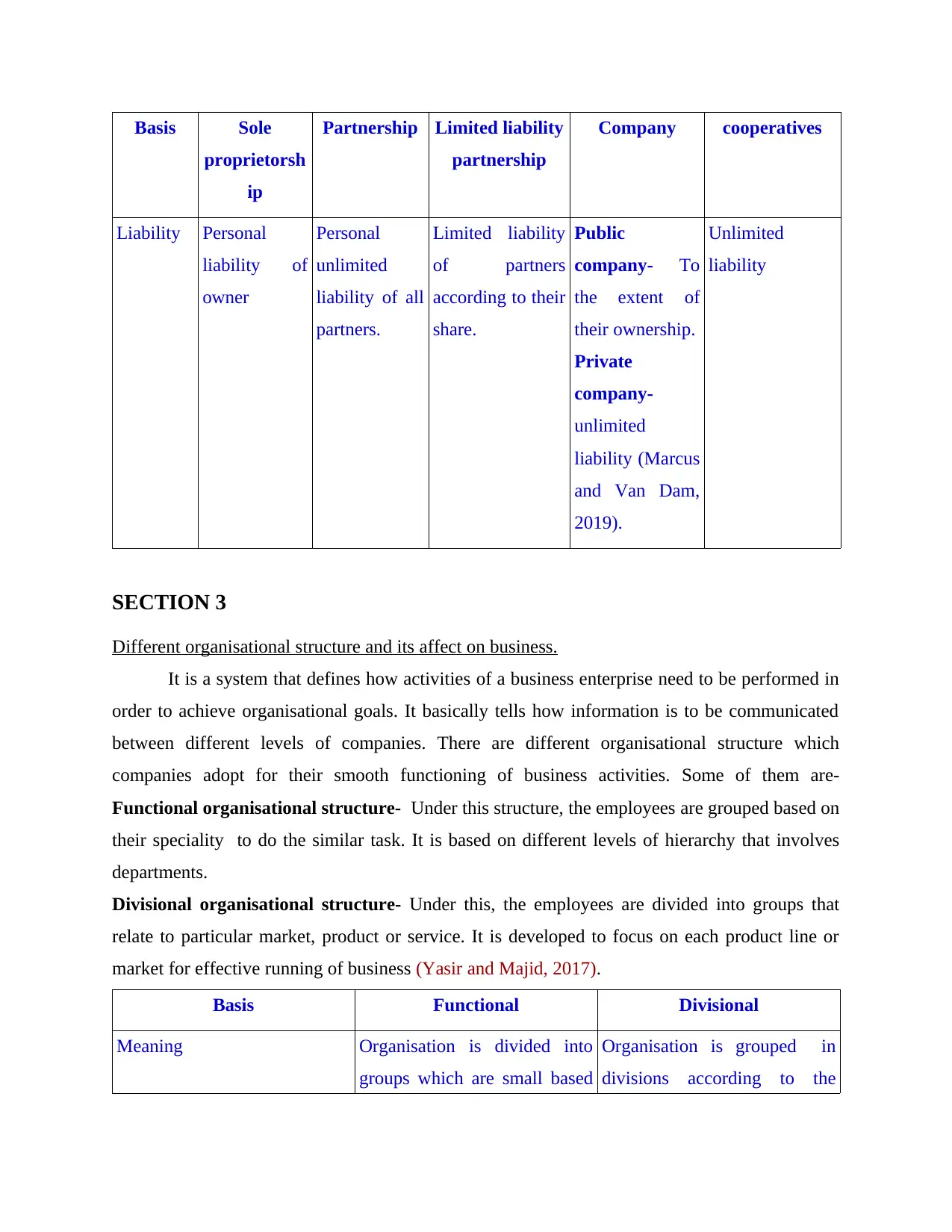
Basis Sole
proprietorsh
ip
Partnership Limited liability
partnership
Company cooperatives
Liability Personal
liability of
owner
Personal
unlimited
liability of all
partners.
Limited liability
of partners
according to their
share.
Public
company- To
the extent of
their ownership.
Private
company-
unlimited
liability (Marcus
and Van Dam,
2019).
Unlimited
liability
SECTION 3
Different organisational structure and its affect on business.
It is a system that defines how activities of a business enterprise need to be performed in
order to achieve organisational goals. It basically tells how information is to be communicated
between different levels of companies. There are different organisational structure which
companies adopt for their smooth functioning of business activities. Some of them are-
Functional organisational structure- Under this structure, the employees are grouped based on
their speciality to do the similar task. It is based on different levels of hierarchy that involves
departments.
Divisional organisational structure- Under this, the employees are divided into groups that
relate to particular market, product or service. It is developed to focus on each product line or
market for effective running of business (Yasir and Majid, 2017).
Basis Functional Divisional
Meaning Organisation is divided into
groups which are small based
Organisation is grouped in
divisions according to the
proprietorsh
ip
Partnership Limited liability
partnership
Company cooperatives
Liability Personal
liability of
owner
Personal
unlimited
liability of all
partners.
Limited liability
of partners
according to their
share.
Public
company- To
the extent of
their ownership.
Private
company-
unlimited
liability (Marcus
and Van Dam,
2019).
Unlimited
liability
SECTION 3
Different organisational structure and its affect on business.
It is a system that defines how activities of a business enterprise need to be performed in
order to achieve organisational goals. It basically tells how information is to be communicated
between different levels of companies. There are different organisational structure which
companies adopt for their smooth functioning of business activities. Some of them are-
Functional organisational structure- Under this structure, the employees are grouped based on
their speciality to do the similar task. It is based on different levels of hierarchy that involves
departments.
Divisional organisational structure- Under this, the employees are divided into groups that
relate to particular market, product or service. It is developed to focus on each product line or
market for effective running of business (Yasir and Majid, 2017).
Basis Functional Divisional
Meaning Organisation is divided into
groups which are small based
Organisation is grouped in
divisions according to the
Paraphrase This Document
Need a fresh take? Get an instant paraphrase of this document with our AI Paraphraser
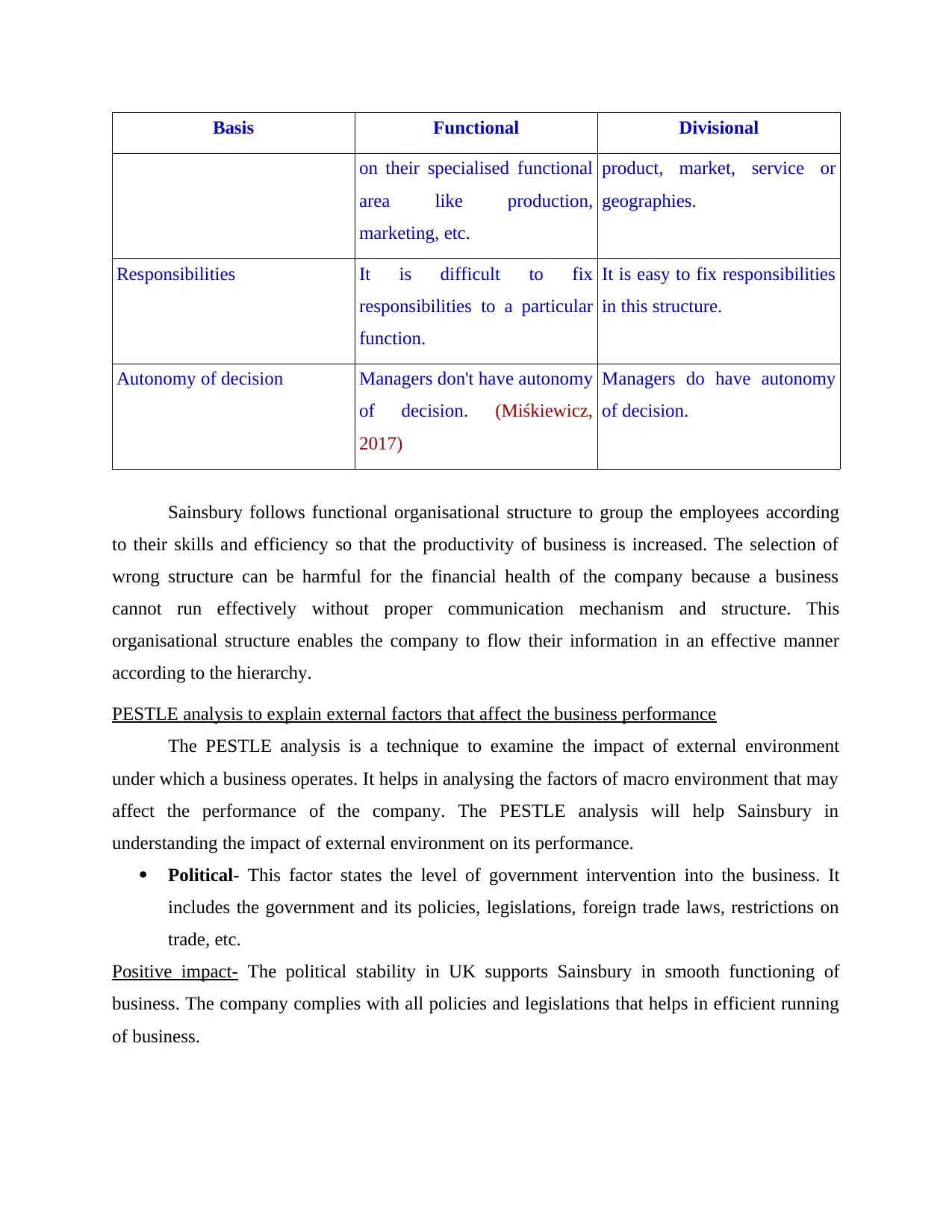
Basis Functional Divisional
on their specialised functional
area like production,
marketing, etc.
product, market, service or
geographies.
Responsibilities It is difficult to fix
responsibilities to a particular
function.
It is easy to fix responsibilities
in this structure.
Autonomy of decision Managers don't have autonomy
of decision. (Miśkiewicz,
2017)
Managers do have autonomy
of decision.
Sainsbury follows functional organisational structure to group the employees according
to their skills and efficiency so that the productivity of business is increased. The selection of
wrong structure can be harmful for the financial health of the company because a business
cannot run effectively without proper communication mechanism and structure. This
organisational structure enables the company to flow their information in an effective manner
according to the hierarchy.
PESTLE analysis to explain external factors that affect the business performance
The PESTLE analysis is a technique to examine the impact of external environment
under which a business operates. It helps in analysing the factors of macro environment that may
affect the performance of the company. The PESTLE analysis will help Sainsbury in
understanding the impact of external environment on its performance.
Political- This factor states the level of government intervention into the business. It
includes the government and its policies, legislations, foreign trade laws, restrictions on
trade, etc.
Positive impact- The political stability in UK supports Sainsbury in smooth functioning of
business. The company complies with all policies and legislations that helps in efficient running
of business.
on their specialised functional
area like production,
marketing, etc.
product, market, service or
geographies.
Responsibilities It is difficult to fix
responsibilities to a particular
function.
It is easy to fix responsibilities
in this structure.
Autonomy of decision Managers don't have autonomy
of decision. (Miśkiewicz,
2017)
Managers do have autonomy
of decision.
Sainsbury follows functional organisational structure to group the employees according
to their skills and efficiency so that the productivity of business is increased. The selection of
wrong structure can be harmful for the financial health of the company because a business
cannot run effectively without proper communication mechanism and structure. This
organisational structure enables the company to flow their information in an effective manner
according to the hierarchy.
PESTLE analysis to explain external factors that affect the business performance
The PESTLE analysis is a technique to examine the impact of external environment
under which a business operates. It helps in analysing the factors of macro environment that may
affect the performance of the company. The PESTLE analysis will help Sainsbury in
understanding the impact of external environment on its performance.
Political- This factor states the level of government intervention into the business. It
includes the government and its policies, legislations, foreign trade laws, restrictions on
trade, etc.
Positive impact- The political stability in UK supports Sainsbury in smooth functioning of
business. The company complies with all policies and legislations that helps in efficient running
of business.
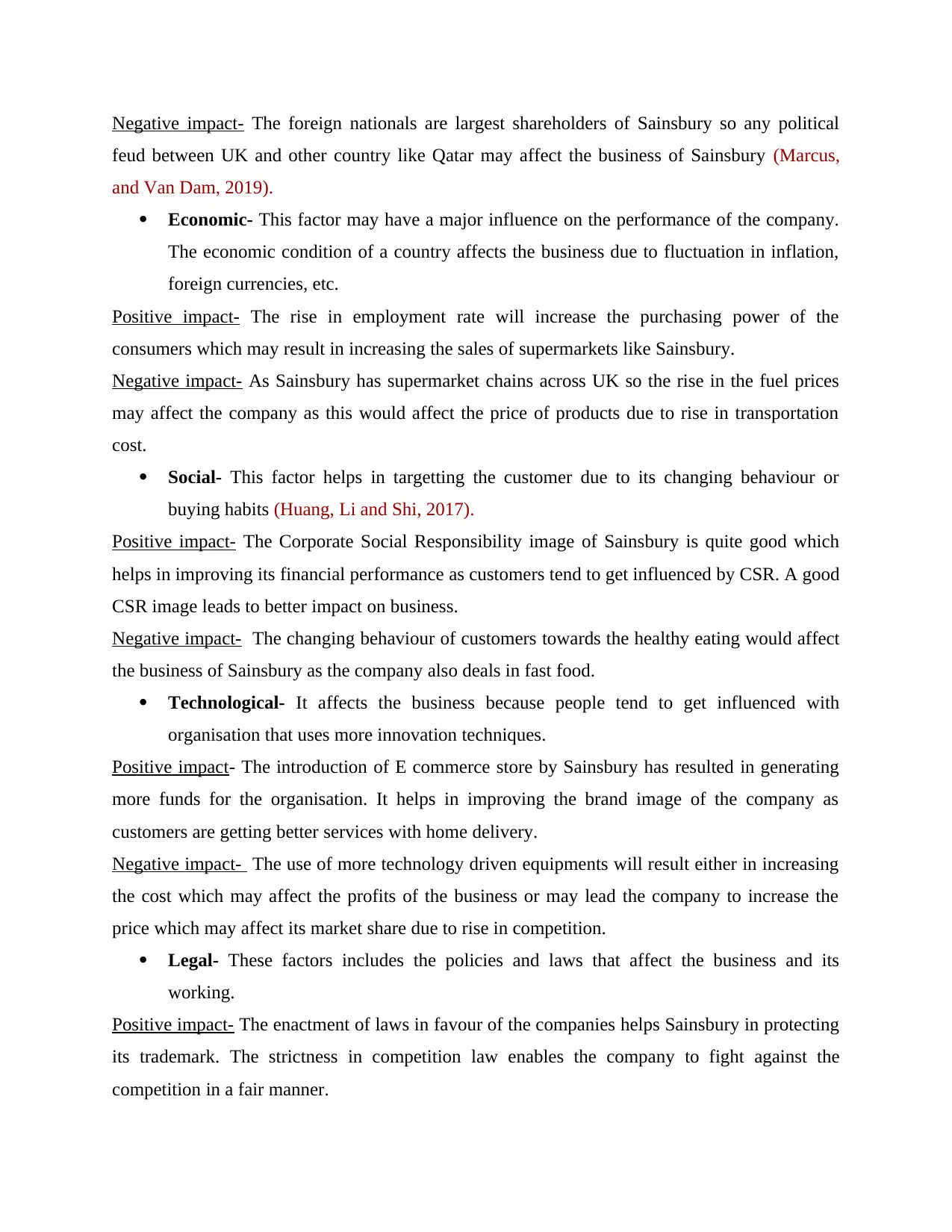
Negative impact- The foreign nationals are largest shareholders of Sainsbury so any political
feud between UK and other country like Qatar may affect the business of Sainsbury (Marcus,
and Van Dam, 2019).
Economic- This factor may have a major influence on the performance of the company.
The economic condition of a country affects the business due to fluctuation in inflation,
foreign currencies, etc.
Positive impact- The rise in employment rate will increase the purchasing power of the
consumers which may result in increasing the sales of supermarkets like Sainsbury.
Negative impact- As Sainsbury has supermarket chains across UK so the rise in the fuel prices
may affect the company as this would affect the price of products due to rise in transportation
cost.
Social- This factor helps in targetting the customer due to its changing behaviour or
buying habits (Huang, Li and Shi, 2017).
Positive impact- The Corporate Social Responsibility image of Sainsbury is quite good which
helps in improving its financial performance as customers tend to get influenced by CSR. A good
CSR image leads to better impact on business.
Negative impact- The changing behaviour of customers towards the healthy eating would affect
the business of Sainsbury as the company also deals in fast food.
Technological- It affects the business because people tend to get influenced with
organisation that uses more innovation techniques.
Positive impact- The introduction of E commerce store by Sainsbury has resulted in generating
more funds for the organisation. It helps in improving the brand image of the company as
customers are getting better services with home delivery.
Negative impact- The use of more technology driven equipments will result either in increasing
the cost which may affect the profits of the business or may lead the company to increase the
price which may affect its market share due to rise in competition.
Legal- These factors includes the policies and laws that affect the business and its
working.
Positive impact- The enactment of laws in favour of the companies helps Sainsbury in protecting
its trademark. The strictness in competition law enables the company to fight against the
competition in a fair manner.
feud between UK and other country like Qatar may affect the business of Sainsbury (Marcus,
and Van Dam, 2019).
Economic- This factor may have a major influence on the performance of the company.
The economic condition of a country affects the business due to fluctuation in inflation,
foreign currencies, etc.
Positive impact- The rise in employment rate will increase the purchasing power of the
consumers which may result in increasing the sales of supermarkets like Sainsbury.
Negative impact- As Sainsbury has supermarket chains across UK so the rise in the fuel prices
may affect the company as this would affect the price of products due to rise in transportation
cost.
Social- This factor helps in targetting the customer due to its changing behaviour or
buying habits (Huang, Li and Shi, 2017).
Positive impact- The Corporate Social Responsibility image of Sainsbury is quite good which
helps in improving its financial performance as customers tend to get influenced by CSR. A good
CSR image leads to better impact on business.
Negative impact- The changing behaviour of customers towards the healthy eating would affect
the business of Sainsbury as the company also deals in fast food.
Technological- It affects the business because people tend to get influenced with
organisation that uses more innovation techniques.
Positive impact- The introduction of E commerce store by Sainsbury has resulted in generating
more funds for the organisation. It helps in improving the brand image of the company as
customers are getting better services with home delivery.
Negative impact- The use of more technology driven equipments will result either in increasing
the cost which may affect the profits of the business or may lead the company to increase the
price which may affect its market share due to rise in competition.
Legal- These factors includes the policies and laws that affect the business and its
working.
Positive impact- The enactment of laws in favour of the companies helps Sainsbury in protecting
its trademark. The strictness in competition law enables the company to fight against the
competition in a fair manner.
⊘ This is a preview!⊘
Do you want full access?
Subscribe today to unlock all pages.

Trusted by 1+ million students worldwide
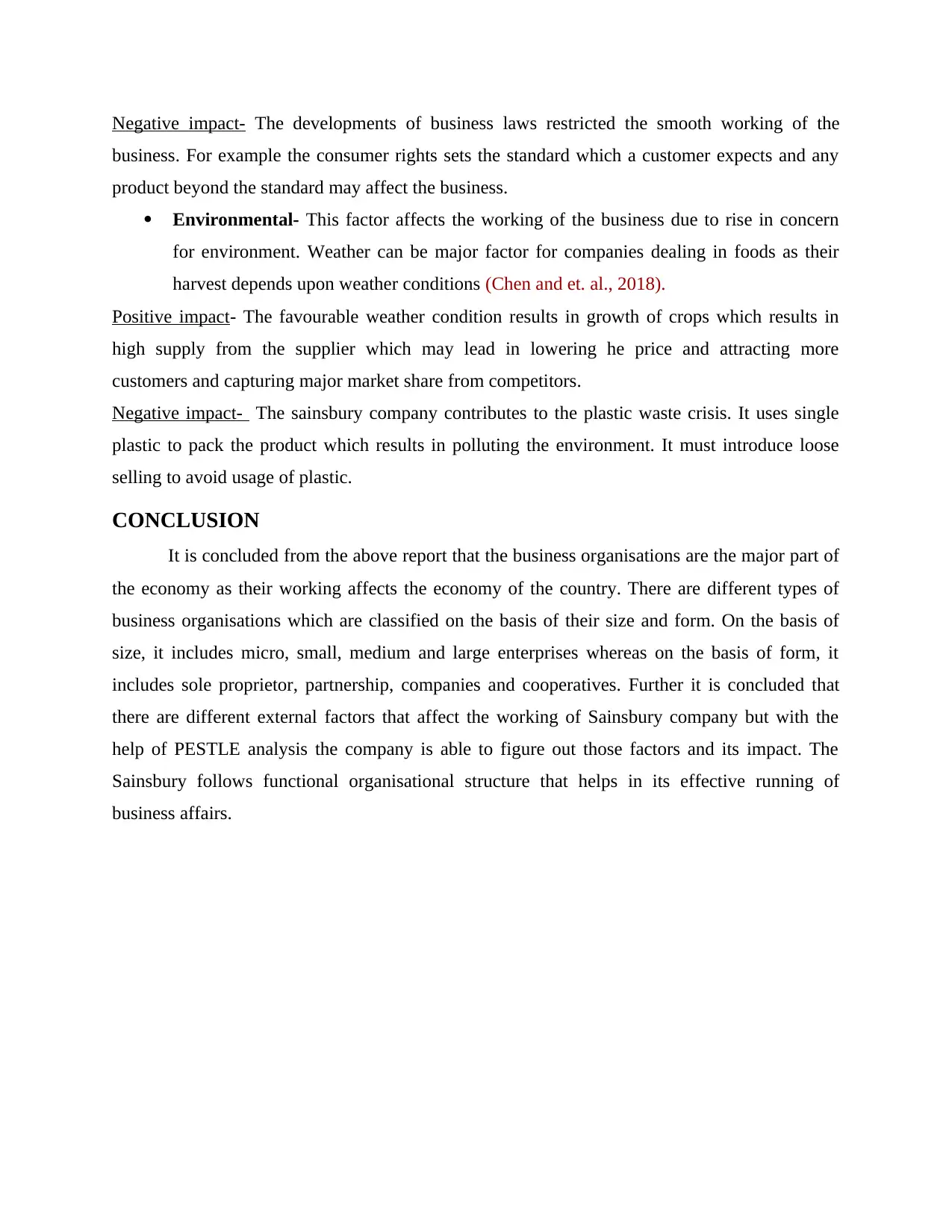
Negative impact- The developments of business laws restricted the smooth working of the
business. For example the consumer rights sets the standard which a customer expects and any
product beyond the standard may affect the business.
Environmental- This factor affects the working of the business due to rise in concern
for environment. Weather can be major factor for companies dealing in foods as their
harvest depends upon weather conditions (Chen and et. al., 2018).
Positive impact- The favourable weather condition results in growth of crops which results in
high supply from the supplier which may lead in lowering he price and attracting more
customers and capturing major market share from competitors.
Negative impact- The sainsbury company contributes to the plastic waste crisis. It uses single
plastic to pack the product which results in polluting the environment. It must introduce loose
selling to avoid usage of plastic.
CONCLUSION
It is concluded from the above report that the business organisations are the major part of
the economy as their working affects the economy of the country. There are different types of
business organisations which are classified on the basis of their size and form. On the basis of
size, it includes micro, small, medium and large enterprises whereas on the basis of form, it
includes sole proprietor, partnership, companies and cooperatives. Further it is concluded that
there are different external factors that affect the working of Sainsbury company but with the
help of PESTLE analysis the company is able to figure out those factors and its impact. The
Sainsbury follows functional organisational structure that helps in its effective running of
business affairs.
business. For example the consumer rights sets the standard which a customer expects and any
product beyond the standard may affect the business.
Environmental- This factor affects the working of the business due to rise in concern
for environment. Weather can be major factor for companies dealing in foods as their
harvest depends upon weather conditions (Chen and et. al., 2018).
Positive impact- The favourable weather condition results in growth of crops which results in
high supply from the supplier which may lead in lowering he price and attracting more
customers and capturing major market share from competitors.
Negative impact- The sainsbury company contributes to the plastic waste crisis. It uses single
plastic to pack the product which results in polluting the environment. It must introduce loose
selling to avoid usage of plastic.
CONCLUSION
It is concluded from the above report that the business organisations are the major part of
the economy as their working affects the economy of the country. There are different types of
business organisations which are classified on the basis of their size and form. On the basis of
size, it includes micro, small, medium and large enterprises whereas on the basis of form, it
includes sole proprietor, partnership, companies and cooperatives. Further it is concluded that
there are different external factors that affect the working of Sainsbury company but with the
help of PESTLE analysis the company is able to figure out those factors and its impact. The
Sainsbury follows functional organisational structure that helps in its effective running of
business affairs.
Paraphrase This Document
Need a fresh take? Get an instant paraphrase of this document with our AI Paraphraser
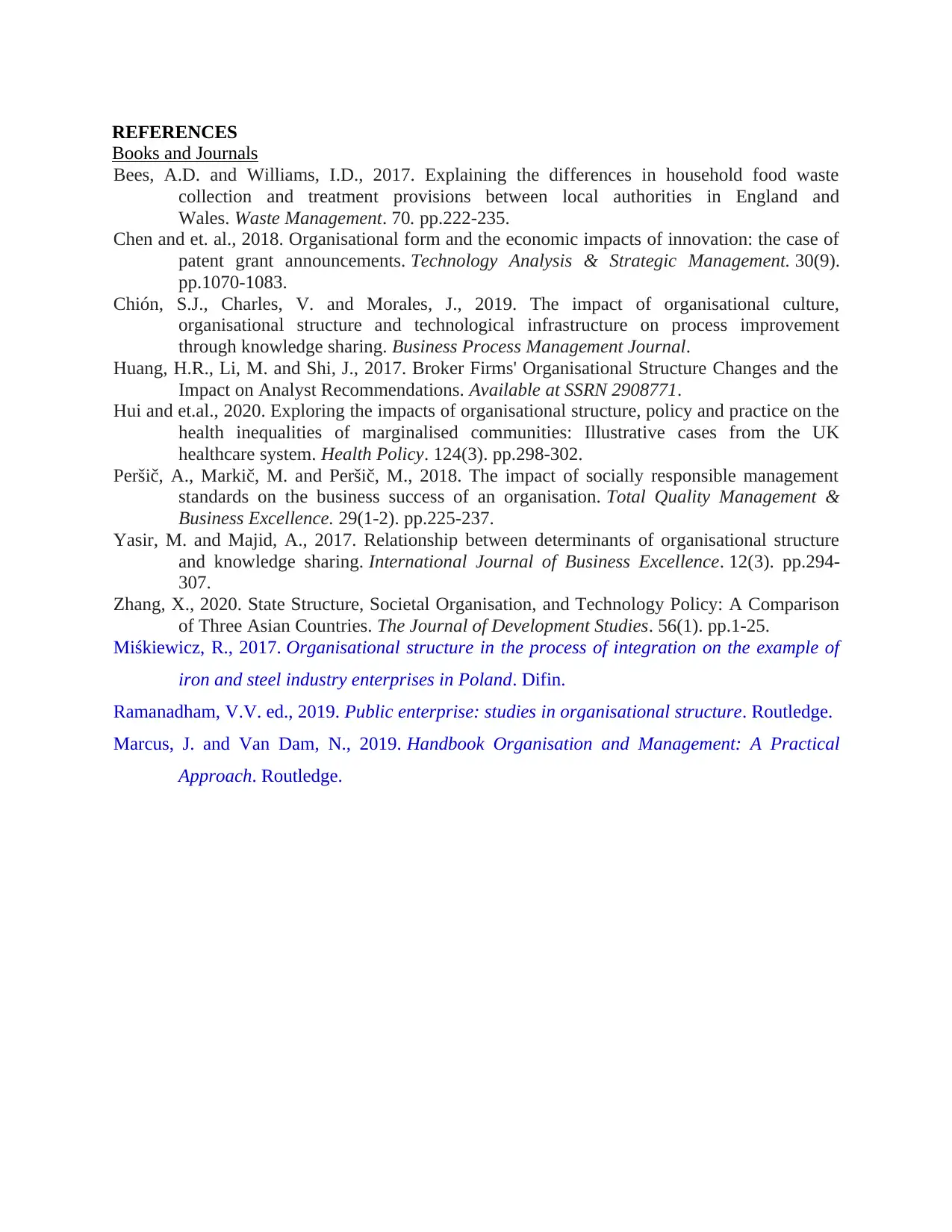
REFERENCES
Books and Journals
Bees, A.D. and Williams, I.D., 2017. Explaining the differences in household food waste
collection and treatment provisions between local authorities in England and
Wales. Waste Management. 70. pp.222-235.
Chen and et. al., 2018. Organisational form and the economic impacts of innovation: the case of
patent grant announcements. Technology Analysis & Strategic Management. 30(9).
pp.1070-1083.
Chión, S.J., Charles, V. and Morales, J., 2019. The impact of organisational culture,
organisational structure and technological infrastructure on process improvement
through knowledge sharing. Business Process Management Journal.
Huang, H.R., Li, M. and Shi, J., 2017. Broker Firms' Organisational Structure Changes and the
Impact on Analyst Recommendations. Available at SSRN 2908771.
Hui and et.al., 2020. Exploring the impacts of organisational structure, policy and practice on the
health inequalities of marginalised communities: Illustrative cases from the UK
healthcare system. Health Policy. 124(3). pp.298-302.
Peršič, A., Markič, M. and Peršič, M., 2018. The impact of socially responsible management
standards on the business success of an organisation. Total Quality Management &
Business Excellence. 29(1-2). pp.225-237.
Yasir, M. and Majid, A., 2017. Relationship between determinants of organisational structure
and knowledge sharing. International Journal of Business Excellence. 12(3). pp.294-
307.
Zhang, X., 2020. State Structure, Societal Organisation, and Technology Policy: A Comparison
of Three Asian Countries. The Journal of Development Studies. 56(1). pp.1-25.
Miśkiewicz, R., 2017. Organisational structure in the process of integration on the example of
iron and steel industry enterprises in Poland. Difin.
Ramanadham, V.V. ed., 2019. Public enterprise: studies in organisational structure. Routledge.
Marcus, J. and Van Dam, N., 2019. Handbook Organisation and Management: A Practical
Approach. Routledge.
Books and Journals
Bees, A.D. and Williams, I.D., 2017. Explaining the differences in household food waste
collection and treatment provisions between local authorities in England and
Wales. Waste Management. 70. pp.222-235.
Chen and et. al., 2018. Organisational form and the economic impacts of innovation: the case of
patent grant announcements. Technology Analysis & Strategic Management. 30(9).
pp.1070-1083.
Chión, S.J., Charles, V. and Morales, J., 2019. The impact of organisational culture,
organisational structure and technological infrastructure on process improvement
through knowledge sharing. Business Process Management Journal.
Huang, H.R., Li, M. and Shi, J., 2017. Broker Firms' Organisational Structure Changes and the
Impact on Analyst Recommendations. Available at SSRN 2908771.
Hui and et.al., 2020. Exploring the impacts of organisational structure, policy and practice on the
health inequalities of marginalised communities: Illustrative cases from the UK
healthcare system. Health Policy. 124(3). pp.298-302.
Peršič, A., Markič, M. and Peršič, M., 2018. The impact of socially responsible management
standards on the business success of an organisation. Total Quality Management &
Business Excellence. 29(1-2). pp.225-237.
Yasir, M. and Majid, A., 2017. Relationship between determinants of organisational structure
and knowledge sharing. International Journal of Business Excellence. 12(3). pp.294-
307.
Zhang, X., 2020. State Structure, Societal Organisation, and Technology Policy: A Comparison
of Three Asian Countries. The Journal of Development Studies. 56(1). pp.1-25.
Miśkiewicz, R., 2017. Organisational structure in the process of integration on the example of
iron and steel industry enterprises in Poland. Difin.
Ramanadham, V.V. ed., 2019. Public enterprise: studies in organisational structure. Routledge.
Marcus, J. and Van Dam, N., 2019. Handbook Organisation and Management: A Practical
Approach. Routledge.
1 out of 11
Related Documents
Your All-in-One AI-Powered Toolkit for Academic Success.
+13062052269
info@desklib.com
Available 24*7 on WhatsApp / Email
![[object Object]](/_next/static/media/star-bottom.7253800d.svg)
Unlock your academic potential
Copyright © 2020–2025 A2Z Services. All Rights Reserved. Developed and managed by ZUCOL.



